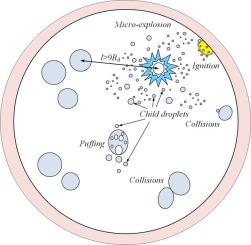Applied Thermal Engineering ( IF 6.4 ) Pub Date : 2020-09-12 , DOI: 10.1016/j.applthermaleng.2020.116023 D.V. Antonov , R.M. Fedorenko , P.A. Strizhak

|
The experimental findings on the movement, evaporation, boiling, and breakup of a group of heterogeneous droplets in a high-temperature gas are presented. The experiments are carried out with droplets moving in a tubular muffle furnace at a temperature of up to 1100 °C. We use emulsion droplets and immiscible droplets consisting of two components: water and Diesel fuel or rapeseed oil. The most typical conditions are singled out for the micro-explosion and puffing of a group of two-component droplets located at a variable distance relative to each other. By varying the distance between droplets (their concentration in a gas), one can control the transition between gradual evaporation without destruction, partial fragmentation throughout the heating time, also known as puffing, and total breakup into a cloud of small droplets, also referred to as micro-explosion. The video frames of the experiments show that even partial fragmentation of initial droplets intensifies the collisions of newly formed droplets with the neighboring ones moving in various echelons. Therefore, we carried out additional experiments to narrow down the necessary conditions for the fragmentation to occur in at least 75% of cases. Chain-like droplet fragmentation mechanisms are observed for droplets moving at a distance of no more than 9 typical sizes from each other. No micro-explosion is observed when the distances between droplets are smaller than that. Finally, we single out the conditions necessary for the ignition of secondary fragments after their production through micro-explosion.
中文翻译:

一组两组分液滴的微爆炸和膨化
给出了在高温气体中一组异质液滴的运动,蒸发,沸腾和破裂的实验结果。实验以液滴在管状马弗炉中在高达1100°C的温度下移动进行的。我们使用由两部分组成的乳液液滴和不溶混液滴:水和柴油燃料或菜籽油。挑出最典型的条件是微炸和膨化一组彼此相对距离不定的两组分液滴。通过改变液滴之间的距离(气体中的浓度),人们可以控制渐进式蒸发而不会破坏,在整个加热过程中部分碎裂(也称为膨化)和完全破碎成小液滴云之间的过渡,也称为微爆炸。实验的视频帧显示,即使初始液滴的部分碎片化,也会加剧新形成的液滴与相邻梯级在不同梯级中运动的碰撞。因此,我们进行了额外的实验,以缩小至少75%的情况下发生碎片的必要条件。观察到链状液滴破碎机制,使液滴彼此之间的距离不超过9个典型大小。当液滴之间的距离小于该距离时,未观察到微爆炸。最后,我们通过微爆炸挑出了次级碎片燃烧后点燃的必要条件。实验的视频帧显示,即使初始液滴的部分碎片化,也会加剧新形成的液滴与相邻梯级在不同梯级中运动的碰撞。因此,我们进行了额外的实验,以缩小至少75%的情况下发生碎片的必要条件。观察到链状液滴破碎机制,使液滴彼此之间的距离不超过9个典型大小。当液滴之间的距离小于该距离时,未观察到微爆炸。最后,我们通过微爆炸挑出了次级碎片燃烧后点燃的必要条件。实验的视频帧显示,即使初始液滴的部分碎片化,也会加剧新形成的液滴与相邻梯级在不同梯级中运动的碰撞。因此,我们进行了额外的实验,以缩小至少75%的情况下发生碎片的必要条件。观察到链状液滴破碎机制,使液滴彼此之间的距离不超过9个典型大小。当液滴之间的距离小于该距离时,未观察到微爆炸。最后,我们通过微爆炸挑出了次级碎片燃烧后点燃的必要条件。我们进行了额外的实验,以缩小至少75%的情况下发生碎片的必要条件。观察到链状液滴破碎机制,使液滴彼此之间的距离不超过9个典型大小。当液滴之间的距离小于该距离时,未观察到微爆炸。最后,我们通过微爆炸挑出了次级碎片燃烧后点燃的必要条件。我们进行了额外的实验,以缩小至少75%的情况下发生碎片的必要条件。观察到链状液滴破碎机制,使液滴彼此之间的移动距离不超过9个典型大小。当液滴之间的距离小于该距离时,未观察到微爆炸。最后,我们通过微爆炸挑出了次级碎片燃烧后点燃的必要条件。



























 京公网安备 11010802027423号
京公网安备 11010802027423号